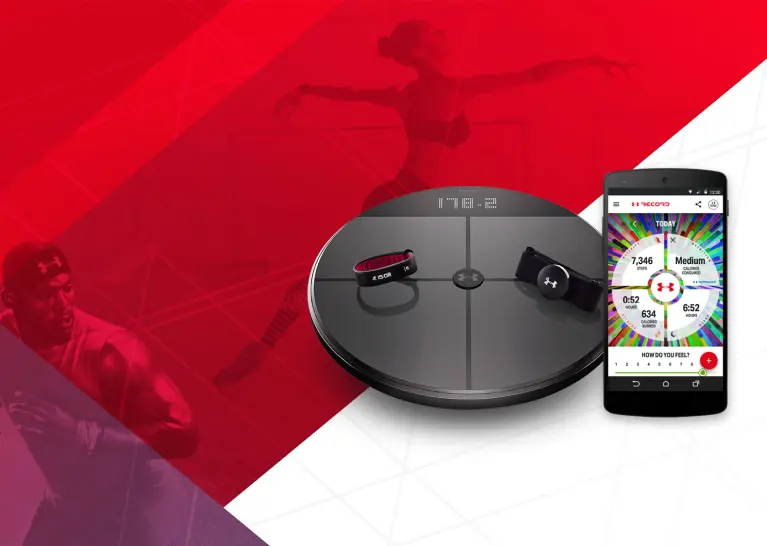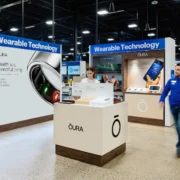How To Build a Great Fitness App, With Mutual Mobile
Partnership
Sponsored By Mutual Mobile

Mutual Mobile has helped Under Armour and Nike build best-in-class apps. Its experts share their wisdom on how fitness brands can win the digital game
The digital experience is everything in 2023. For fitness brands, having an app that’s well-conceived, intuitive and engaging can make the difference between a successful business and one that flops.
Mutual Mobile, an innovation consultancy that helps companies design, build and manage digital products, has worked with some of the leading brands in fitness, health and wellness, including Under Armour and Nike.
Among its successes, the Austin, Texas,-based firm helped Under Armour create Record, an app the sportswear company launched to drive sales for its HealthBox, a connected fitness product designed to track sleep, fitness activity and nutrition via a heart rate monitor, wristband and scale.
The Record app, introduced in 2016, was used by 1.94 million users and saw over 2.6 billion workouts and activities logged. Under Armour won eight awards at CES 2016, including the Wearable Best in Show, for its Record and HealthBox products.

Mutual Mobile worked closely with Under Armour on virtually every aspect of Record from start to finish, including the app’s name itself, noted David Garlinski, Mutual Mobile’s Senior Director of Strategic Accounts.
“It was a real collaborative effort,” Garlinski said, adding that Mutual Mobile has done other projects for Under Armour since then, including helping to overhaul the company’s online shopping app, UA Shop.
“They still come back to us periodically,” he says.
Mutual Mobile has also designed apps for a social fitness company that encourages people to be active through team movement challenges and a sports tech company that makes a calf compression sleeve that tracks users’ metabolic activity and lactate threshold.
Garlinski and Prasanna Tolasati, Mutual Mobile’s Lead Project Manager for fitness tech, spoke with Athletech News about how fitness brands can build apps that attract users and ultimately drive sales.
Understand your users and what they want
Fitness brands, like many companies, often underestimate the vast amount of market research that’s needed in order to build a great app, according to Tolasati.
“It’s something we’ve had to assist almost every client with,” he says. “You need to do that research to understand the problem you’re trying to solve and who you’re trying to solve it for, because fitness has its own answers for different types of people.”
Market research needs to be deep enough to glean meaningful insights into an app’s users and potential users.
“I’ve seen quite a few instances with fitness influencers who have blue checkmarks on Instagram and Twitter, and they’re basically just putting out an open question on their stories asking, ‘What features would you like to see?’” Tolasati says. “That’s too vague to understand what users actually want.”
Instead, brands should take the time to carefully consider the demographics of the user base they’re targeting with a particular product, including age, socioeconomic status and geographic region. Something as fundamental as the optimal subscription price for an app or service can vary significantly depending on those factors.
Talking to industry experts can be a useful way for fitness brands to get data that will ultimately improve their apps.
For brands that intend to offer tracking services, “asking a coach or a personal trainer how they like to track their clients’ workouts or how their clients want their workouts tracked is important,” noted Tolasati, who is an ACE-certified personal trainer himself.

True to its mission of providing clients with an end-to-end solution for apps and other digital products, Mutual Mobile can help fitness brands perform market research.
“We have product owners and product managers who know what queries you need to run, what surveys you need to conduct, the type of frameworks that you have to implement to get that information and translate it into building a minimum viable product,” Tolasati explains.
Apps should be engaging, but they need to work
Functionality is key; the fun stuff can – and should – be added later.
When Mutual Mobile was working with a U.K.-based social fitness app, the first thing the firm did was make sure the app worked the way it was supposed to for users every time they turned it on. Mutual Mobile also planned for the app’s future growth.
“When they came to us, they were experiencing major issues; it was crashes or specific bugs, and notifications that weren’t firing properly,” Garlinski said of the social fitness company’s initial app.
Mutual Mobile ironed those issues out first and then went to work on building out new features and enhancing aesthetics. For every app, there needs to be a solid foundation to build upon.
The U.K.-based company had a great app with a rough back-end, the foundation, noted Garlinski. But the work Mutual Mobile proposed to their executive team set them right and established a way forward to building past their MVP (Minimum Viable Product).
The social fitness app is designed around team movement challenges where people can join together with friends, family and colleagues to set goals for physical activity and healthy habits, all with the objective of reaching the top of a mountain for a specific challenge. An example would be a group of friends setting a team goal of burning 10,000 calories in seven days.
To drive engagement and make users want to open the app on their phones every day, Mutual Mobile built an array of features that added “little pieces of delight” throughout the app, Garlinski said.
“Each time you worked out, you got a notification about the summary of your workout, and it gave you some delight with confetti falling on the screen, and the guy had his arm raised because he was excited,” he noted. “Once you got to the top of the mountain, you got to plant your flag.”

Reduce friction to keep users around
You can build the best app in the world, but if users don’t stick around long enough to appreciate its features, that won’t matter.
“Friction is a big deal,” Garlinski says. “A good portion of people fall off during the tutorials or the onboarding because it takes too much time.”
Mutual Mobile has worked with clients to shorten their apps’ onboarding duration, or even give users the option of skipping onboarding initially and coming back to it later instead.
“If you get to test drive a car, you should be able to test drive an app,” Garlinski says.
And a 7-day free trial might not be long enough if an app is packed with features, especially those that may take longer than a week for users to fully appreciate.
“A lot of apps don’t give you the opportunity to completely see what the app does before they make you buy,” Garlinski noted, adding that it’s important for brands to carefully balance monetizing an app with the need to build a solid user base.
Be realistic about budget
Like prospective homeowners, companies planning an app often fail to account for maintenance costs.
“A lot of folks that come to us have the idea to design their Ferrari or their multimillion dollar home, and they have the funds to buy it, but they don’t have the funds to maintain it,” Garlinski says.

“Code isn’t perfect,” he notes. “You have to make sure that you have the right resources in place to handle bug fixes, handle the person who comes and says, ‘Why doesn’t your app do this?’”
In addition to bug fixes, Garlinski says companies should plan for software updates that Apple and Google roll out for the iOS and Android operating systems, new devices and updates to core software like Apple HealthKit and Google Fit, among other potential maintenance considerations.
“It’s not a build once, deploy and forget process,” Garlinski says of a fitness brand’s mobile app.
Less is more: focus on a few key features
Fitness brands looking to score high on user experience should resist the urge to cram a million and one features into an app, according to Tolasati.
“Fewer features that are more valuable to users is definitely better than 150 features that most people hardly use,” Tolasati says.
He mentioned the Nike Training Club App as a good example of what most brands should be shooting for. The NTC App integrates data from fitness wearables like the Apple Watch, but doesn’t overwhelm users with an abundance of features, Tolasati noted.
“It’s a very well-defined product,” he says. “It may not have as many functionalities as something like the Garmin App, but it doesn’t need to, because it’s not meant for sport-specific users.”
Going beyond apps: getting everything else right
While building best-in-class apps is Mutual Mobile’s bread and butter, the firm helps companies, including fitness brands, with all aspects of their digital ecosystem.
“Apps only work if back-end works,” Garlinski noted. “We’re not a one-stop shop for mobile apps, we do a lot more.”
Mutual Mobile can help fitness brands build admin portals, for example. The firm also provides strategic advice to companies on which third-party chat or notification providers they should work with if they want their apps to have those kinds of functionalities.
“If your product is simply a POS system at the gym, we can help you build that out too, or integrate the POS into your custom app,” Garlinski adds. “White-label services are fine, but they’re not customizable. We’re custom, and we can help you build out custom (mobile) applications, desktop applications or anything like that.”



